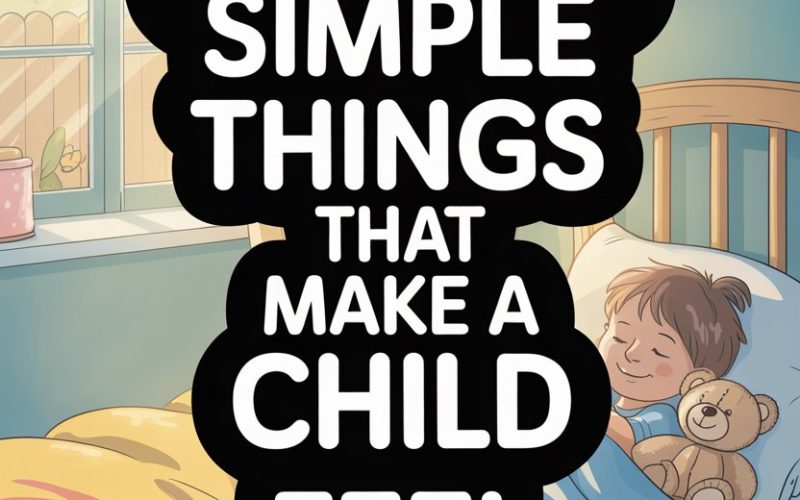Ever watched a child melt down because their crusts weren’t cut off, only to then recover after a cuddle and a silly song? Children are surprisingly easy to rattle, but—good news—they’re also easy to reassure.
Security isn’t just about house alarms or nightlights. It’s woven into the tiny, everyday moments you share.
If you’re a busy parent (and if you’re reading this with one eye on your emails, I see you), the following seven simple things can make a world of difference in how safe and steady your child feels in this sometimes wobbly world.
1. Predictable Routines (Even When Life Isn’t Predictable)
Let’s be honest: Even the most organized calendar can fall victim to a stomach bug or a surprise Zoom meeting.
Still, a basic structure—breakfast, teeth, shoes, school—gives children the sense that the ground won’t fall out from under them.
Routines signal to kids that life ticks along, and they don’t have to guess what comes next.
Research from the American Academy of Pediatrics highlights that simple routines, especially around bedtime, help children sleep better and behave better.
If you’re working late or dinner is more toast than three courses, keeping the basics (story, snuggle, lights out) steady can help your child’s world feel reassuringly familiar.
Even a quick “here’s what’s happening today” chat in the morning can work wonders.
2. Consistent Boundaries and Gentle Discipline
Every parent has experienced the joy of a child pushing boundaries—sometimes with the determination of a seasoned lawyer. “But why can’t I have biscuits for breakfast?”—on repeat.
Clear, consistent boundaries (with rules that don’t change by the hour or your caffeine levels) signal that you’re in charge, and that’s comforting.
It’s not about being a drill sergeant. Children need to know you mean what you say. Warmth plus limits equals safety.
Gentle discipline—think time-ins instead of timeouts, calm explanations, and consequences that make sense—keeps things secure without turning your home into a boot camp.
Dr. Laura Markham, author of Peaceful Parent, Happy Kids, points out that limits set with empathy reduce anxiety and help children self-regulate.
3. Undivided Attention (Even In Small Doses)
You don’t need endless hours of floor time with blocks and dolls. (If you do have that kind of time, please tell me your secrets.)
A few minutes of truly undivided attention—a puzzle together, a silly voice at storytime, eye contact while you listen to today’s playground drama—goes a long way.
One study from Harvard’s Center on the Developing Child describes these “serve and return” interactions as the gold standard for building secure attachment.
Put down the phone (unless you’re showing them a video of a tap-dancing dog, obviously), and let them feel like they matter more than your notifications.
4. Affection—Physical and Verbal
Some children are cuddly koalas. Others would rather high-five from across the room. No matter where your child sits on the affection spectrum, regular, genuine warmth matters.
Hugs, kisses, ruffling their hair, or even just a hand squeezed warmly—these acts reassure children on a deep, biological level.
Turns out, skin-to-skin contact releases oxytocin, sometimes called the “love hormone,” which literally calms frazzled nerves (see the research from the University of California, Los Angeles).
Verbal affection counts too. A “I love you, mate” whispered at bedtime, praise for tying their own shoelaces, or a simple “I’m so glad you’re my kid” will find its mark.
5. Honest Reassurance During Stressful Times
Life throws curveballs. New siblings, school moves, sick grandparents, world events, or—heaven help us—another round of chickenpox.
When your child’s world wobbles, what they need most is simple, honest reassurance from you.
It’s tempting to paper over the cracks with “it’s fine, nothing’s wrong!” Instead, aim for the truth but filtered through a calm, confident lens.
“Yes, Dad’s got to work late for a while, but he’ll always come home for bedtime stories.” Or “You might feel a bit nervous at your new school, but you can always talk to me.”
According to child psychologist Dr. Becky Kennedy, naming feelings and sharing basic facts helps kids process change and fear without letting their imaginations run wild.
6. Safe Physical Spaces
You don’t need a Pinterest-worthy playroom or a backyard that looks like a theme park. Children crave nooks that feel safe and theirs, even if it’s just a corner of the living room with their favourite blanket and a stack of books.
Safety is partly about childproofing and partly about familiarity.
A bed with the same battered teddy, a nightlight that flickers reassuringly, or a kitchen stool always ready for “helping” at tea time—these little things are anchors in a stormy sea.
Even as they grow, teens benefit from spaces where they can retreat, flop, and sulk in peace. (Yes, even the ones who swear they don’t want to talk to you.)
7. Rituals, Traditions, and Family Quirks
Nothing says “you belong here” like a family ritual. Big or small, simple or bonkers, rituals stitch together ordinary days into a comforting patchwork.
Maybe it’s Friday night pizza, silly songs in the car, or a secret handshake that makes you look a bit ridiculous in the school run queue. The specifics don’t matter—the magic is in the repetition.
These shared moments become shorthand for “we’re a team,” reassuring children that home is more than just four walls.
Research from Emory University suggests that children who know their family’s stories and traditions handle stress better and feel more secure.
Bringing It All Together—Security Grows in Small Moments
Perfection is not required. No one’s asking you to clone Mary Poppins or host nightly family pow-wows.
The secret is consistency, warmth, and a little bit of attention, delivered in the ways that suit your family’s personality and schedule.
So tonight, when you’re frazzled and the bedtime routine’s gone off-piste, remember that the simple things—a cuddle, a predictable story, a quiet reassurance—are what your child will carry with them long after the dishes are done.
And if they insist on sleeping with every stuffed animal in the house? Well, who says security can’t come with a side of chaos.





